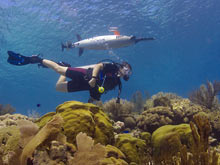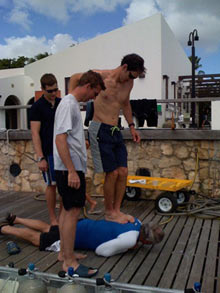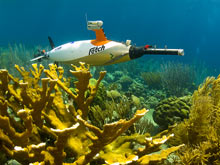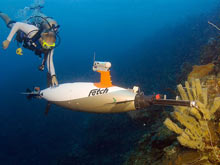Expedition members descending to the deep reef using trimix technical diving. Trimix alters the proportion of breathing gases found in air by replacing some of the nitrogen with helium, an inert gas that helps reduce some of the pressure-related maladies of deep diving. With proper training, NOAA scientific trimix divers can explore the deeper reef to depths as great as 90 meters (295 feet). Click image for larger view and image credit.
Fetch1 surveys shallow environments, too. Populations of this species of Acropora palmata (elkhorn coral) were seriously affected by recent hurricanes that have passed close to Bonaire, where high waves broke and scattered colonies. Click image for larger view and image credit.
Dengue Fever, International Year of the Reef, and the Future
January 30, 2008
Mark Patterson
Expedition Chief Scientist
Associate Professor of Marine Science
Director, Autonomous Systems Laboratory
Virginia Institute of Marine Science, College of William & Mary
As our nearly month-long expedition concludes, I feel a mixture of conflicting emotions . . . The satisfaction of a ground-breaking expedition safely accomplished by humans and machines. ( “Every day is a good day when the AUV comes home” was our insider joke slogan.) Sadness at our imminent departure, leaving the friends we have made with our island hosts and among ourselves, the stunning scenery below and above the waterline, the break-up of a tight team that worked well during demanding long days and nights. Relief at the upcoming break from grueling daily labor, lugging dive gear and robots hither and yon.
The second half of the expedition was punctuated for me by interesting new experiences — one not welcome! The third week of our Bonaire expedition, I contracted Dengue fever, a viral illness transmitted by mosquito. Dengue is the Number 1 emerging tropical disease, according to the World Health Organization. I found its nickname, "break-bone fever," apt. Every day with the disease was no fun. The team rose to the challenge of my physical (and mental!) limitations, carrying my dive gear, enforcing food, water, and rest, and making merciless fun of my condition. And on the seventh day, still feeling as bad as on the second, my immune system starting rowing with all oars and within the span of four hours I felt completely cured. A very bizarre ending to a very bizarre illness. Unfortunately, dengue is spreading rapidly around the tropical and subtropical zones of the planet, a consequence of global warming. In fact, tropical illnesses are spreading around the planet rapidly. A Harvard medical school researcher, Paul Epstein, remarked to the Washington Post that things that were projected to occur in 2080 are happening in 2006. So, as we study changes to Bonaire below the waterline, unfortunately things are changing above the waterline in unexpected and unwelcome ways.
Last week was the kickoff of the International Year of the Reef, and NOAA, our expedition patron, held its own conference with an international flavor to highlight the U.S. government’s commitment to protecting the world’s coral reefs. We were invited by the NOAA Administrator, Vice Admiral Conrad Lautenbacher, to participate in the news conference from Bonaire. We quickly decided that our local hosts, the management body Stichting Nationale Parken Nederlandse Antillean (STINAPA), and the island government leaders should be completely involved in the event. Bonaire is an international treasure and the island government’s foresight to enact various protective measures stretching back to 1961, with full protection in 1979, was a driving reason why we were here to re-survey.
The press conference came off without a hitch. Jim Leichter from Scripps, Art Trembanis from University of Delaware, and myself gave succinct overviews of the expedition’s technology, approach, and initial findings. To quote what I said to the press:
We decided to come to Bonaire for scientific research because it has been viewed as being a pristine environment. However, like reefs world-wide, we found Bonaire is changing, and this rate of change is accelerating. We are seeing some troubling factors including: the spread of macroalgae from the deep to shallow reef, the spread of an invasive species of tunicate, and a cyanobacterium mat (blue-green algae) that may be killing coral. We are seeing more dead and dying coral than we should be seeing on healthy reefs. These troubling aspects are most evident between 10 to 30 meters depth. With our robotic technology and divers in the water, we are sighting some really large colonies (several hundred years old) of brain and star corals that appear to have recently declined. And we have evidence from prior observations that the water clarity for Bonaire, which is an oceanic island, is not what is should be.
There are some signs of hope that the health of Bonaire’s reefs, arguably still the best left in the Caribbean, can be improved. First, in the shallow reefs, recruitment of staghorn and elkhorn coral species is evident in sections where hurricanes have caused past damage. Second, we are seeing a small number of black spiny sea urchins (Diadema) living amongst the coral heads. An important omnivore on coral reefs, this species was obliterated by a pathogen back in the early 80s, so it is good to see it returning slowly. Third, herbivorous fishes are in seemingly good shape. These fishes are vital to keeping algae on the reef in check.
Finally, our preliminary work indicates the deeper reef, greater than 30 m depth, appears to be in better shape than the 10 to 30 meters depth range. We are conducting a unique inventory by using 3 free-swimming robots, called Autonomous Underwater Vehicles, or AUVs for short. This is the first time a field campaign using such technology has been conducted in a reef setting. We hope our maps will prove valuable to the island government of Bonaire as they consider new ways to manage their underwater park.

Noelle Relles, a graduate student at Virginia Institute of Marine Science, swims with the Fetch1 AUV. Diver surveys complemented the AUV datasets. Relles' graduate work will address how much Bonaire's reefs have changed since the last synoptic large-scale survey in 1985. Click image for larger view and image credit.
The press conference concluded with the Honorable Herbert Domacassé, Lt. Governor of Bonaire, and the island’s leader, presenting a passionate view of how Bonaireans view their reefs and how they will be unwavering in stewardship. Later that week, we gave a standing-room only talk, open to the lay public and hosted by the Council on International Educational Exchange (CIEE) in Kralendijk. The talk showed us how interested the average Bonaire resident was in what lay underwater and how importantly they viewed reef protection, which was gratifying to see.
The expedition’s data are voluminous. The robots dove hundreds of times and the trimix and Nitrox teams logged dozens of dive hours. Everyone’s skin took a beating from the constant immersion, the hot sun, and the regular application of DEET to avoid ending up like the Chief Scientist (who contracted the mosquito-borne Dengue fever). There is a sense that, in addition to the many science papers we will write about our research here, we want to create something special that will help the stewards of Bonaire’s reefs.
Initial discussions among team members took place concerning plans to make our own atlas, similar in spirit to Dr. Fleur van Duyl’s effort, which was published in 1985. The aim is to produce something useful to a marine park manager or government planner, but also beautiful to look at. Work on the atlas will begin sometime in 2009, after we have processed our sonar, photo, and video data.

The island's leader, the Honorable Herbert Domacassé, Lt. Governor of Bonair (left front) and Dr. Ramón de Leon (left back), manager of the Bonaire National Marine Park, listen as Dr. Art Trembanis (right front) explains some of the preliminary findings from the AUV surveys, just prior to the NOAA International Year of the Reef press conference. Meanwhile, Dr. James Leichter (right back) reviews his prepared remarks for the press. Click image for larger view and image credit.

Drs. Daniel Jones and Dale Stokes watch as Dr. Leichter, standing on a prone Dr. Mark Patterson, renders an antidote to break-bone, aka Dengue, fever. Dr. Patterson's expression of the disease included a sensation that his spine was in the process of breaking. Paradoxically, this "treatment" helped! Click image for larger view and image credit.
A heartfelt thanks to the U.S. taxpayers who funded our work, and “masha danki” to the tireless government workers of the island of Bonaire, especially Ramón de Leon, Elsmarie Beukenboom, and Frank van Slobbe, and the residents of Bonaire who provided impromptu support of many kinds. We will remember this expedition fondly the rest of our lives.
Sign up for the Ocean Explorer E-mail Update List.





























